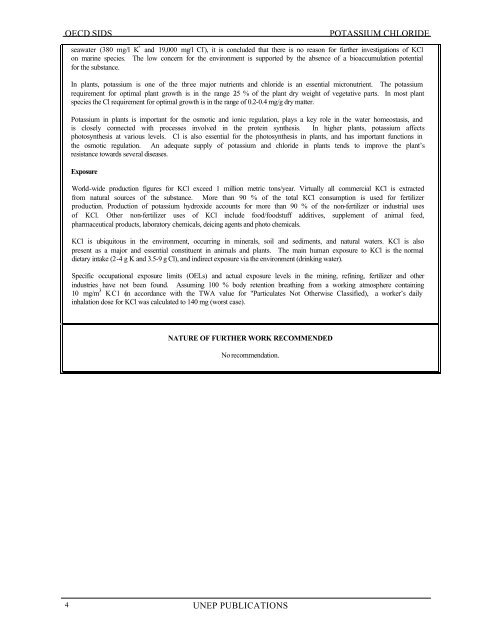POTASSIUM CHLORIDE CAS N°: 7447-40-7
POTASSIUM CHLORIDE CAS N°: 7447-40-7
POTASSIUM CHLORIDE CAS N°: 7447-40-7
Create successful ePaper yourself
Turn your PDF publications into a flip-book with our unique Google optimized e-Paper software.
OECD SIDS <strong>POTASSIUM</strong> <strong>CHLORIDE</strong><br />
seawater (380 mg/l K + and 19,000 mg/l Cl - ), it is concluded that there is no reason for further investigations of KCl<br />
on marine species. The low concern for the environment is supported by the absence of a bioaccumulation potential<br />
for the substance.<br />
In plants, potassium is one of the three major nutrients and chloride is an essential micronutrient. The potassium<br />
requirement for optimal plant growth is in the range 2-5 % of the plant dry weight of vegetative parts. In most plant<br />
species the Cl requirement for optimal growth is in the range of 0.2-0.4 mg/g dry matter.<br />
Potassium in plants is important for the osmotic and ionic regulation, plays a key role in the water homeostasis, and<br />
is closely connected with processes involved in the protein synthesis. In higher plants, potassium affects<br />
photosynthesis at various levels. Cl is also essential for the photosynthesis in plants, and has important functions in<br />
the osmotic regulation. An adequate supply of potassium and chloride in plants tends to improve the plant’s<br />
resistance towards several diseases.<br />
Exposure<br />
World-wide production figures for KCl exceed 1 million metric tons/year. Virtually all commercial KCl is extracted<br />
from natural sources of the substance. More than 90 % of the total KCl consumption is used for fertilizer<br />
production. Production of potassium hydroxide accounts for more than 90 % of the non-fertilizer or industrial uses<br />
of KCl. Other non-fertilizer uses of KCl include food/foodstuff additives, supplement of animal feed,<br />
pharmaceutical products, laboratory chemicals, deicing agents and photo chemicals.<br />
KCl is ubiquitous in the environment, occurring in minerals, soil and sediments, and natural waters. KCl is also<br />
present as a major and essential constituent in animals and plants. The main human exposure to KCl is the normal<br />
dietary intake (2-4 g K and 3.5-9 g Cl), and indirect exposure via the environment (drinking water).<br />
Specific occupational exposure limits (OELs) and actual exposure levels in the mining, refining, fertilizer and other<br />
industries have not been found. Assuming 100 % body retention breathing from a working atmosphere containing<br />
10 mg/m 3 KCl (in accordance with the TWA value for "Particulates Not Otherwise Classified), a worker’s daily<br />
inhalation dose for KCl was calculated to 1<strong>40</strong> mg (worst case).<br />
NATURE OF FURTHER WORK RECOMMENDED<br />
No recommendation.<br />
4<br />
UNEP PUBLICATIONS
















